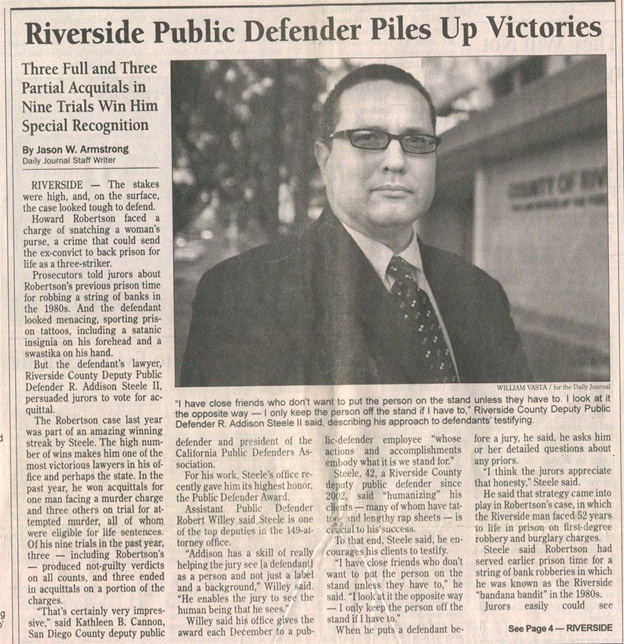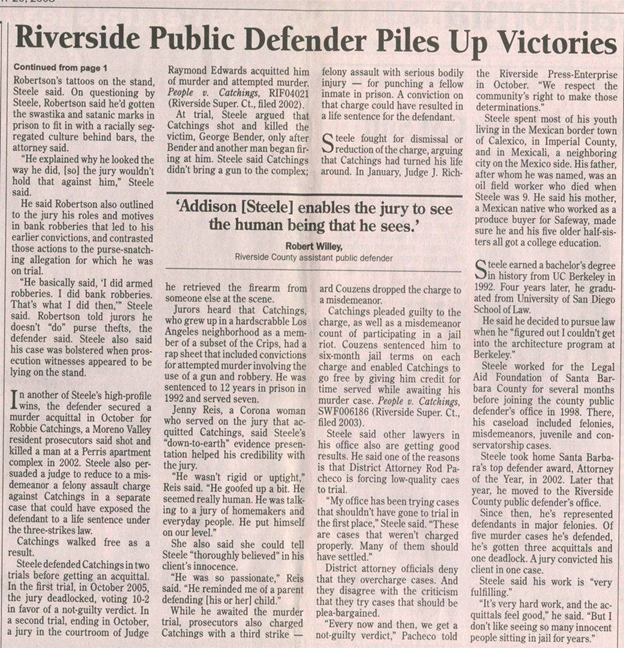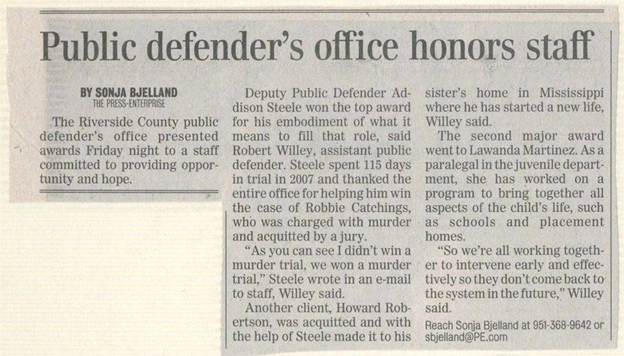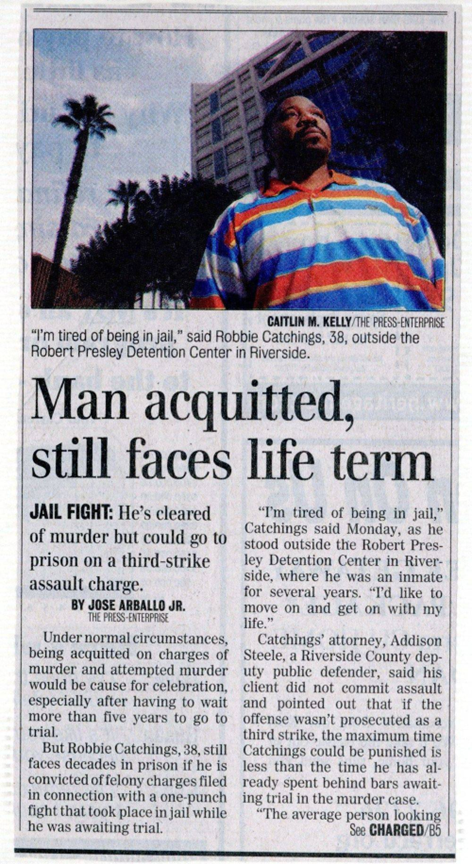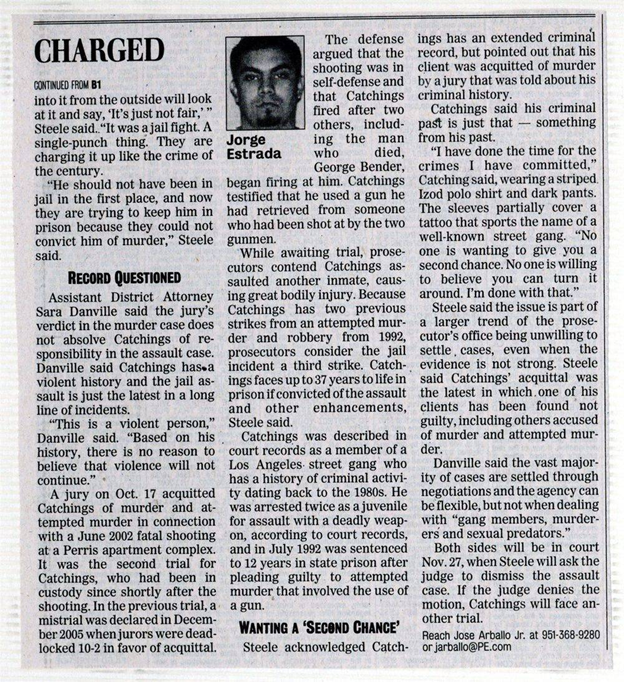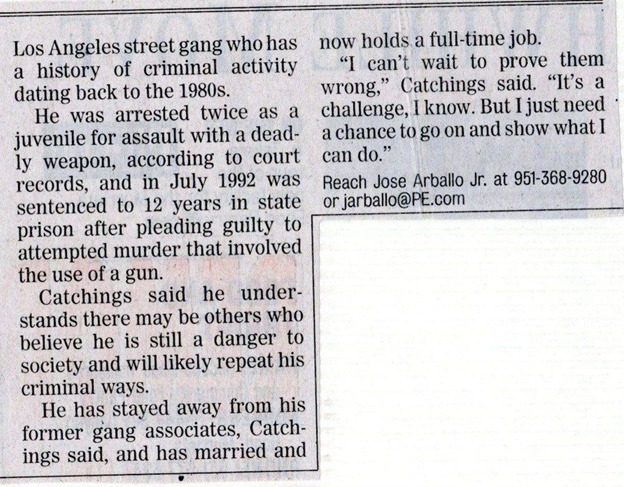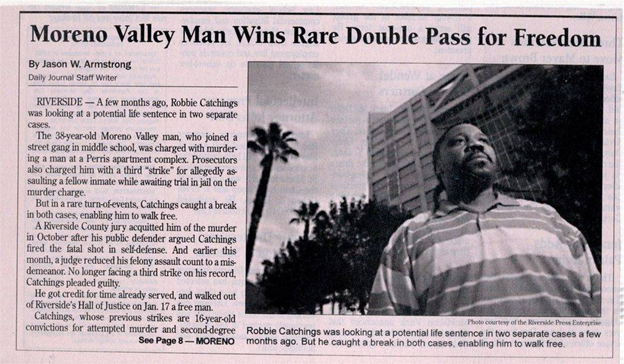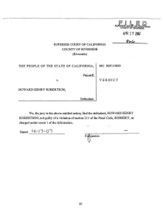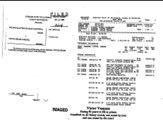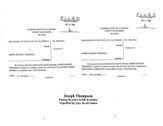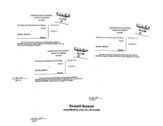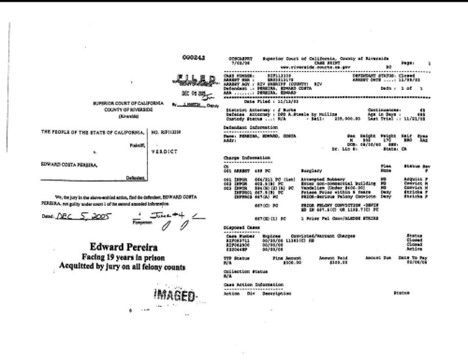Three Strikes Cases
Addison Steele has:
Extensive experience handling Three Strikes cases. There are three different aspects of three strikes cases. The first is when a person has a charge that is defined in the Penal Code as either violent or serious. That means that a conviction for the charge will result in the person having a strike, and having a strike has extreme consequences. The next is when a strike prior is charged. Having a strike prior makes the person probation ineligible, that means that the person must go to prison unless either the district attorney or the judge "strikes the strike." However, that's not all, the sentence is also doubled because of the strike prior. The last is when there are at least two strike priors alleged and the charged crime is either violent or serious. In that case the person is facing a mandatory sentence of at least 25 years to life in prison, unless either the judge or district attorney "strikes" all but one of the strike priors.
If someone has either a current charge that's a strike, or one or more prior strikes alleged, that person has to have an attorney that's experienced in negotiating strikes cases and getting strike priors "struck." It is imperative to negotiate strike to non-strike charges and to negotiate to have prior strikes struck. If that cannot be done then the attorney has to have experience doing strikes jury trials.
Addison knows how to negotiate strike cases, and when the district attorney or judge will not strike the strikes, he knows how to do the jury and have success.
Addison has done six jury trials where the client was facing a life sentence because of two strike priors and he saved the client from a life sentence. He has done 50 jury trials where the client was charged with at least one strike and from those has 106 acquitted counts.
Three strikes cases are difficult because petty crimes can result in life in prison sentences in some cases and long sentences in other cases. There was recently a change in the three strikes law by voter referendum, Proposition 36 (that's the new Prop. 36 that addresses the three strikes law, not the old Prop. 36 that addresses drug treatment in drug cases). A person can no longer be "struck out," that is, receive a life sentence for petty crimes in most cases. However, that is not the situation in all cases; there are some strike priors that still allow a person to be struck out for petty crimes.
It's not just three-strike cases that require an attorney with knowledge and experience in the area; just one strike prior doubles a prison sentence and makes it so a client cannot get probation and must go to prison. In order to save a client that's charged with three strikes from a life sentence, either the trial has to be won, or a Romero motion (a motion to strike the strike prior) has to be won. It is critical to have an attorney who is experienced in handling three strike cases, that has negotiated three strikes cases, has saved clients' lives by winning three strike trials, and has saved clients' lives by winning Romero motions. It's also imperative to have an experienced lawyer that can keep a person from getting strikes in the first place. If you need to hire a lawyer for a three strikes case, you need a lawyer who has experience with three strike trials and who has won three strikes trials that have gone before a jury.
Addison has has not only done thirteen three-strikes trials, but he has had full acquittals on all felony charges in four of those trials, and he has saved his clients from life sentences in six of those trials, including a three strikes murder case. He has saved so many clients' lives by winning Romero motions that he doesn't even track them. His record of trial wins in three strikes cases and winning Romero motions is unparalleled.
It's always advantageous to negotiated three strikes cases instead of having to risk a trial. Some recent negotiated outcomes are:
Fernando P., 23CR03877
Fernando was facing 76 years to life to prison because of his two prior strikes. Addison started by trying to convince the judge to release Fernando to a treatment program. Unfortunately that was not successful because Fernando was facing such a serious sentence. The case was negotiated for the district attorney strike one of the strike priors and resolve the case for five years. He will have to serve half of that sentence. California Department of Corrections and Rehabilitation (CDCR) can eliminate two years of that sentence if they choose to, meaning that he will likely be home in less than a year and half.
Omar S.R., 23CR09003
Omar was charged with a strike assault. The allegation was that he participated in a jail fight. He was charged with assault with serious bodily injury, which is a strike, assault with great bodily injury, which was another way of charging the same incident, which is a strike, and criminal threats which is a strike. He was also on felony probation when the alleged incident occurred. The district attorney wanted him to plead to at least one strike and go to prison. Omar’s family then hired the Steele Law Firm and Addison got to work on the case. A few weeks later Addison and Omar were able to resolve the case with a plea to a non-strike charge for credit for time and go home. Below is picture of Addison and Omar outside of the jail right after he was released.

Robbie C., RIF104021
- Charges: Murder (Penal Code § 187(a)), attempted murder (Penal Code § 664/187(a), felon in possession of a firearm (Penal Code § 12021(a)(1), special allegations of personal use of a firearm (Penal Code § 12022.53(d), a prison term prior (Penal Code § 667.5(b), serious crime prior (Penal Code § 667(a) and three prior strikes (Penal Code § 667(c)&(e)(2)/1170.12(c)(2)).
- Exposure: Robbie was facing 171 years to life in prison.
- Outcome: There were two trials; the first trial ended in a hung jury, with the jury deadlocked at ten to two for acquittal. At the second trial, Robbie was found not guilty of all charges.
This was a really challenging murder case. The allegation was that Robbie shot at two men for no apparent reason killing one and wounding the other. The case was made more challenging because Robbie had two strike priors, so if he was convicted of any one of the charges he would be sentenced to at least 25 years to life in prison. So the felon in possession of firearm alone would result in a life in prison sentence. What had in fact happened was that Robbie was confronted by his best friend who mistakenly believed that Robbie had become involved with his girlfriend. The evidence presented at trial was that Robbie had grown up in South Los Angeles and when he was younger was an Eleven Eight East Coast Crips (Eleven Eight was for 118th Street in South Los Angeles and East Coast Crips did not have anything to do with the East Coast, it means the eastern side of South Los Angeles). It was an environment where the slightest disrespectful act could have deadly results, so his best friend believing that Robbie was involved with his girlfriend was a very serious matter. The evidence that Addison and Robbie presented at trial was that after his best friend confronted Robbie, the two separated and were about forty feet apart in the courtyard of an apartment complex. His best friend was standing next to another man talking and Robbie was standing next to another man talking, they were all former Eleven Eight East Coast Crips gang members and all knew each other. Robbie was the only person that was not armed. All of sudden, his best friend pulled out his gun and began firing at Robbie. The man Robbie was next to pulled out his gun to fire back, he got off some shots but then dropped the gun in the chaos. While they were being shot at Robbie picked up the gun and also fired back. Robbie's best friend and the man he was with were both shot, but Robbie best friend succumbed to his wounds. There were many people in the apartment complex that heard the shootout and many people that witnessed only a portion of it. The district attorney presented a theory that Robbie shot his best friend and another that they grew up with for no known reason. The first trial resulted in a hung jury. Robbie offered fourteen years just to avoid the risk of 171 years to life in prison. The district attorney rejected the offer on the theory that he would be able to send Robbie to prison for life on the felony in possession of a firearm alone because Robbie had two prior strikes. However there's an exception to felon in possession of a firearm--if a person's life is in danger and that person comes upon a firearm, he is allowed to possess the gun to defend himself. The exception matched the facts of what had happened to Robbie. At the second trial the jury acquitted Robbie of all charges and he went home. However the district attorney wasn't done. In the years that Robbie had been in jail waiting for both trials, he had gotten into a one punch jail fight. The district attorney charged that jail fight as a felony assault so Robbie was again looking at twenty-five years to life in prison. Addison wrote and argued a motion to reduce that charge to a misdemeanor. The motion was granted and Robbie was given credit for time served. Addison had saved Robbie's life a second time.

Robbie, Addison, and the investigators on the case after the verdict
Robbie was featured in an article in the Los Angeles Daily Journal that was done about my winning so many trials. Addison has been told, but has not been able to confirm, that the Los Angeles Daily Journal has never done an article like this about any other criminal defense attorney.
Riverside Public Defender Piles Up Victories: Three Full and Three Partial Acquittals in Nine Trials Win Him Special Recognition, Jason W. Armstrong, Los Angeles Daily Journal, Volume 121, Number 32, February 20, 2008.
"In another of Steele's high-profile wins, the defender secured a murder acquittal in October for Robbie Catchings, a Moreno Valley resident prosecutors said shot and killed a man at a Perris apartment complex in 2002. Steele also persuaded a judge to reduce to a misdemeanor a felony assault charge against Catchings in a separate case that could have exposed the defendant to a life sentence under the three-strikes law. Catchings walked free as a result. . . . Jenny Reis, a Corona woman who served on the jury that acquitted Catchings, said Steele's 'down-to-earth' evidence presentation helped his credibility with the jury. . . . She also said she could tell Steele 'thoroughly believed' in his client's innocence. 'He was so passionate,' Reis said. 'He reminded me of a parent defending [his or her] child.'"
Robbie was also featured in a newspaper article covering when I was named Riverside County Public Defenders Office Attorney of the Year.
- Public defender's office honors staff, Sonja Bjelland, The Press-Enterprise, Local B7, December 9, 2007.
"The Riverside County public defender's office presented awards Friday night to a staff committed to providing opportunity and hope.
Deputy Public Defender Addison Steele won the top award for his embodiment of what it means to fill that role, said Robert Willey, assistant public defender. Steele spent 115 days in trial in 2007 and thanked the entire office for helping him win the case of Robbie Catchings, who was charged with murder and acquitted by jury.
'As you can see I didn't win a murder trial, we won a murder trial,' Steele wrote in an e-mail to staff, Willey said."
The newspaper article covering when I was named the Riverside County Public Defender’s Office Attorney of the Year.
- After we won the murder trial, the district attorney tried to give Robbie a life in prison sentence because he was a third striker and had gotten in a jail fight while he was waiting for his trial. He was acquitted of all charges. I filed a series of motions, including a bail motion when they tried to have Robbie sent back to jail, a motion to dismiss the jail fight case, a motion to strike the strike priors, and a motion to reduce the jail fight charge to a misdemeanor. The judge reduced the case to a misdemeanor. Robbie pled guilty to the misdemeanor for credit for time already served, and it was finally all over. Robbie was able to go home and take care of his ailing mother.
The first newspaper article about the district attorney trying to give Robbie a life sentence after they lost his murder trial.
An interesting side note about this article is that Jorge Estrada, whoever he is, had absolutely nothing to do with the case; his picture in the article is a copy editor's mistake.
This is the newspaper article covering when Robbie and I beat the district attorney's attempt to strike Robbie out after we had won the murder trial.
The Los Angeles Daily Journal article covering Robbie and Addison's three strikes victory that saved Robbie from a life sentence in prison for a second time.
Daniel H., RIF130179
- Charges: Domestic violence with a domestic violence prior (Penal Code § 273.5(e)), five prison term priors (Penal Code § 667.5(b)) and two strike priors (Penal Code § 667(c)&(e)(2)(A)/1170.12(c)(2)).
- Exposure: Danny was facing thirty years to life in prison.
- Outcome: Despite his ex-wife testifying that Danny had beaten her bloody, sending her to the hospital, the jury acquitted Danny on all charges. He was found not guilty of domestic violence and all the lesser included offenses. Danny was immediately released and has lived crime-free.
Danny, Addison, and the investigator on the case after the verdict
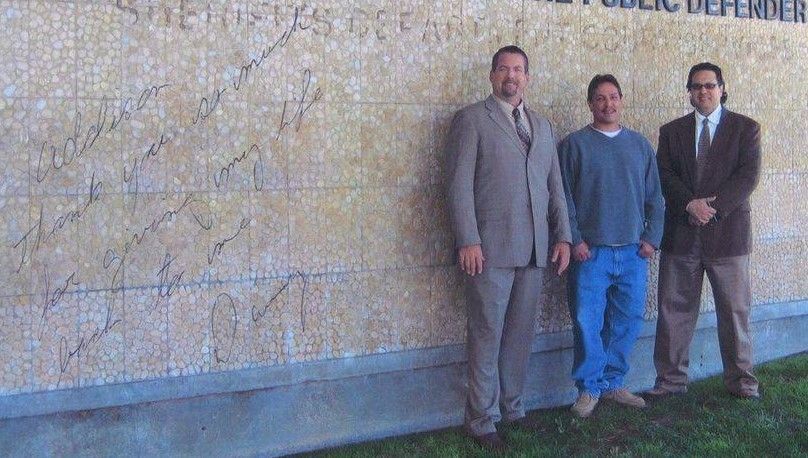
Howard R., RIF115020
- Charges: Robbery (Penal Code § 211) and residential burglary (Penal Code § 459) with four prison term priors (Penal Code § 667.5(b)), five serious crime priors (Penal Code § 667(a)) and five strike priors (Penal Code § 667(c)&(e)(2)(A)/1170.12(c)(2)).
- Exposure: Howard was looking at fifty-four years to life in prison.
- Outcome: Howard was acquitted of all charges and released from jail. He moved to Tennessee to live with his brother, made a living as a painter, trained defense lawyers on prison gangs, and even testified as a gang expert at a trial. He, unfortunately, was the victim of a river drowning accident. His family said that he died doing what he loved, enjoying being free in the outdoors.
Howard, Addison, and the investigator on the case after the verdicts.
Howard was also featured in the article in the Los Angeles Daily Journal about my trial successes, which is above in the Robbie Catchings section of this page.
- Riverside Public Defender Piles Up Victories: Three Full and Three Partial Acquittals in Nine Trials Win Him Special Recognition, Jason W. Armstrong, Los Angeles Daily Journal, Volume 121, Number 32, February 20, 2008.
"The stakes were high, and, on the surface, the case looked tough to defend.
Howard Robertson faced a charge of snatching a woman's purse, a crime that could send the ex-convict back to prison for life as a three-striker.
Prosecutors told jurors about Robertson's previous prison time for robbing a string of banks in the 1980s. The defendant looked menacing, sporting prison tattoos, including a satanic insignia on his forehead and a swastika on his hand.
But the defendant's lawyer, Riverside County Deputy Public Defender R. Addison Steele II, persuaded jurors to vote for acquittal.
The Robertson case last year was part of an amazing winning streak by Steele. The high number of wins makes him one of the most victorious lawyers in his office and perhaps the state. In the past year, he won acquittals for one man facing a murder charge and three others on trial for attempted murder, all of whom were eligible for life sentences.
. . .
'That's certainly very impressive,' said Kathleen B. Cannon, San Diego County deputy public defender and president of the California Public Defenders Association.
For his work, Steele's office recently gave him its highest honor. The Public Defender Award.
Assistant Public Defender Robert Willey said Steele is one of the top deputies in the 149-attorney office.
'Addison has a skill of really helping the jury see [a defendant] as a person and not just a label and a background,' Willey said."
Howard, Addison and the investigator on the case.

This is the Verdict Form where Howard was found NOT GUILTY of robbery. He was found NOT GUILTY of all charges, saving him from a three-strike life sentence.
Victor V., RIF131050
- Charges: Assault with a car (Penal Code § 245(a)(1), hit and run (Vehicle Code § 20001(a)), and later driving under the influence (Vehicle Code §§ 23152(a)&(b)) with three strike priors (Penal Code § 667(c)&(e)(2)(A)/1170.12(c)(2)).
- Exposure: Victor was facing fifty years to life in prison.
- Outcome: Despite Victor's girlfriend's testimony that Victor had tried to run her over with his pickup truck, the jury acquitted Victor of all charges, except a conceded unrelated driving under the influence charge. Victor was given credit for time served for the DUI and released from jail. He now runs his own lawn care business.
Above is the Verdict Form and Minute Order from Victor's case that shows him being acquitted on all felony counts and saved from a life sentence.
Ruben T., RIF105360
- Charges: Possession of methamphetamine for sales (Health and Safety Code § 11378), felon in possession of ammunition (Penal Code § 12316(b)(1)) and possession of drug paraphernalia (Health and Safety Code § 11364), with two strike priors (Penal Code § 667(c)&(e)(2)(A)/1170.12(c)(2)).
- Exposure: Ruben was facing fifty years to life in prison.
- Outcome: The jury found Ruben not guilty of felon in possession of ammunition and possession of drug paraphernalia; the jury hung eleven to one in favor of acquittal on the possession of methamphetamine charge. The case later settled for Ruben pleading guilty to simple possession of methamphetamine, and the district attorney dismissed one of the strikes, and Ruben was sentenced to two years and eight months in prison, although it was ridiculous for him to have to go to prison, it was much better than 50 years to life.
This case was a battle from the beginning. This trial was in 2004 when because of the Three Strikes law a person could easily get a life sentence for possession of a small amount of drugs. The fight started by trying to get Ruben out from under the Three Strikes law with a Romero motion (a motion asking the judge to strike the strike priors so the defendant is not facing a life sentence) and a 17(b) motion (a motion to reduce the charges to misdemeanors so the defendant is not facing a life sentence). Unfortunately the case had been assigned to Judge Charles Morgan, easily one of the worse judges in Riverside County. A fair trial, or even basic fair treatment, was not something that was going to be had in Judge Morgan's courtroom. Both motions that would have saved Ruben from a life sentence were denied by Judge Morgan. That meant the case needed to go to trial in a courtroom where there would not be fair rulings and where defense counsel and the defendant could count on not being able to fully present a defense to the jury. Judge Morgan presided over a trial where the district attorney was prosecuting a woman for using methamphetamine while she was breastfeeding her baby. The attorney in that case said in the press that Judge Morgan was incompetent. His assessment of the judge's ability was absolutely correct.
The Sheriff's Department did a parole search of Ruben's home and found a coin purse with 16 grams of methamphetamine in it in a common area. They found two digital scales and empty Ziploc bags in a Hello Kitty box. They found $764 in Ruben's wallet; he had a fulltime job so the source of the money could be proved. They went into a bedroom and found a used methamphetamine pipe with an additional half a gram of methamphetamine. There were also four bullets in that bedroom's closet. Addison and Ruben presented evidence that Ruben had a female roommate and that it was her bedroom, not his, where the items were found. Despite the evidence that it was the roommate who had the drugs, the district attorney pressed on wanting to convict Ruben of possession for sales of methamphetamine with a theory that even if they lost that and he was only convicted of possession for personal use he would spend the rest of his life in prison. The trial was only six days, not for a lack of trying to present a full defense, but because Addison and Ruben were shut down at every step trying to present their case. However, there was something that Judge Morgan and the district attorney could not control, that was the jury. They acquitted him of possession of ammunition and possession of drug paraphernalia. They hung 11 to 1 in favor of acquittal on the possession for sales for count. It looked like Addison and Ruben were going to have to gear up to try the again. However, Ruben had already been in jail for more than a year when Addison got the case and because of Riverside County's crowded courts it had been almost two years by the time the trial ended. Ruben decided to offer the minimum sentence with only one strike prior which meant that he would "do a turnaround" at Chino State Prison, the California Department of Corrections "reception center" for Riverside County. The district attorney accepted that offer which meant that Ruben and Addison would not have to risk a life sentence in a second trial and Ruben would be home in a matter of months.
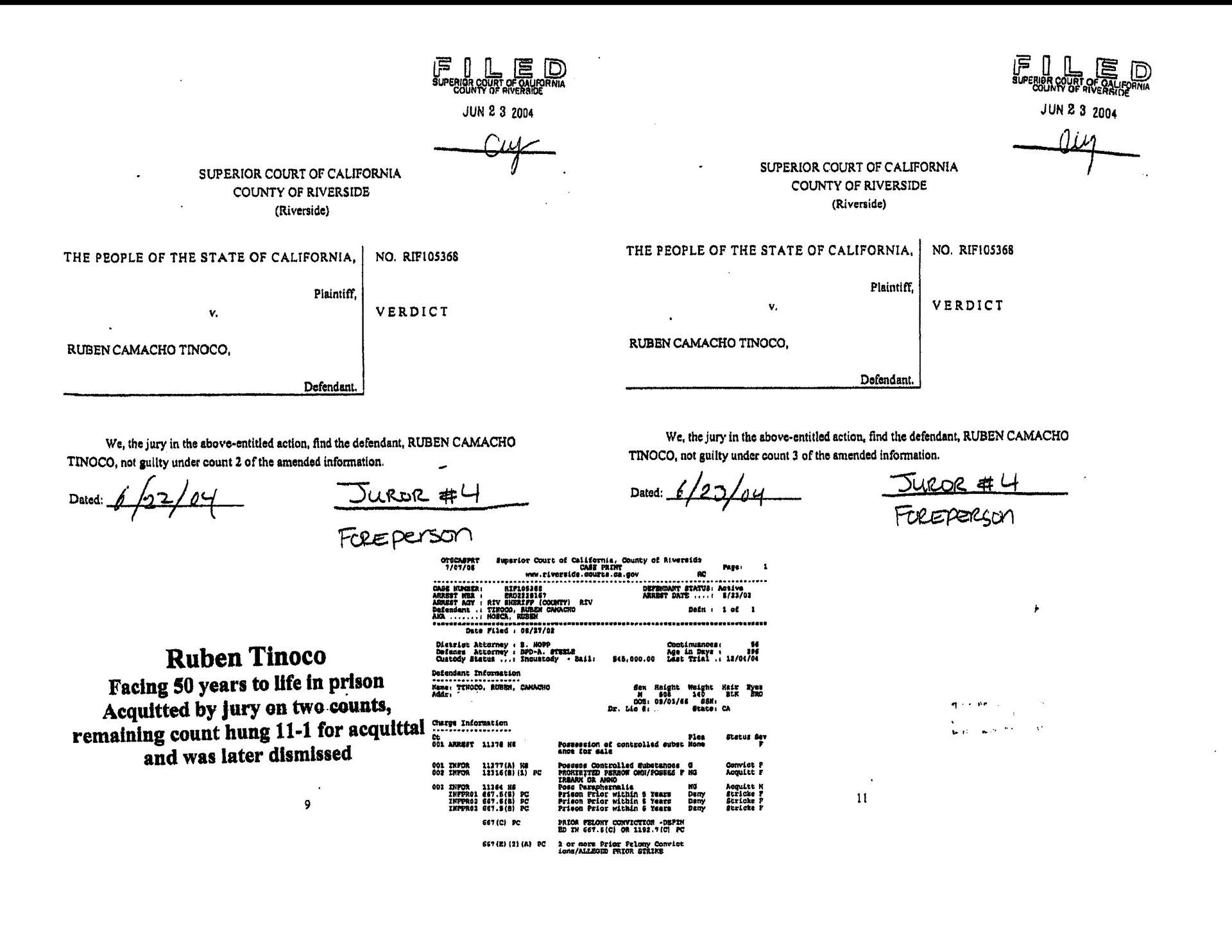
The verdict forms and Minute Order where Ruben was saved from a fifty years to life prison sentence,
and instead was only sentenced to two years, eight months.
Joseph T., RIF126216
- Charges: Robbery (Penal Code § 211) with a strike prior (Penal Code § 667(c)&(e)(2)(A)/1170.12(c)(2)), prison term prior (Penal Code § 667.5(b)), and serious crime prior (Penal Code § 667(a)).
- Exposure: Joe was looking at sixteen years in prison. His case actually started out as a life-in-prison exposure case because he was charged with two additional out-of-state strikes. I challenged those strikes before the trial began and got them dismissed.
- Outcome: Acquitted of all charges. Joe was immediately released from jail directly from the courtroom. Joe and I then went and had lunch, where I started a tradition of buying a carne asada burrito for the first meal back to freedom for my clients who have been released from jail after an acquittal.
The verdict forms where Joe was found NOT GUILTY on all charges.
My one strike prior (which, if lost, means that the client is probation ineligible and must be sent to prison, and the prison sentence is doubled) trial successes.
Ronnell B., RIF113393
- Charges: Domestic violence (Penal Code § 273.5(a)) with a prison term prior (Penal Code § 667.5(b)) and a strike prior (Penal Code § 667(c)&(e)(2)(A)/1170.12(c)(2)).
- Exposure: Ronnell was facing ten years in prison.
- Outcome: Despite his girlfriend testifying that he had hit and injured her, Ronnell was acquitted of all charges, which were domestic violence and all the lesser included offenses, and released from jail.
The verdict forms where Ronnell was found NOT GUILTY on all charges and saved from a possible ten-year prison sentence. Ronnell had a strike prior, so if he had lost even one felony count, he had to be sent to prison with a doubled sentence.
Edward P., RIf113339
- Charges: Attempted robbery (Penal Code § 664/211) and residential burglary (Penal Code § 459), with a strike prior (Penal Code § 667(c)&(e)(2)(A)/1170.12(c)(2)), prison term prior (Penal Code § 667.5(b)) and serious crime prior (Penal Code § 667(a)).
- Exposure: Edward was looking at sixteen years in prison
- Outcome: He was found not guilty of all felonies; he was only convicted of the conceded misdemeanors of trespassing and vandalism. He was sentenced to credit for time served and immediately released from jail.
The Verdict Form and Minute Order were where Edward was saved from nineteen years in prison because he was acquitted of all felony charges and sentenced to credit for time served for the misdemeanor convictions. He was released from jail and went home.
Questions you should ask an attorney that you are considering hiring for a three-strikes case:
- Have you done a three-strike trial before?
- This question is important because a three strike trial involves complex issues and requires the ability to address the strike priors. Three strikes cases require specialized knowledge and experience.
- Addison has done twelve three strikes trials, seven of which he saved the client from a life sentence.
- What were the results of your three strikes trials?
- This question is important because, in a three-strikes trial, a loss means a life sentence in prison. If there's only one strike prior alleged it means that the person cannot get probation and will get a doubled sentence. If an attorney has won three strikes trials and saved clients from life sentences, that attorney has the experience and skills to handle the level of complexity involved in a three-strikes trial.
- Addison has won four three strikes trials by winning all of the felony counts, including a three strikes murder trial. Typically, a defense attorney expects to win maybe one in ten trials because the district attorney can choose not to have a trial in any case in which they think they cannot win. Addison's win rate far exceeds that. If you find another attorney who has done the number of three-strike trials that Addison has done and has had more successful outcomes than he has, and who has beaten three-strike cases and saved as many lives as he has, hire that person. If you want the best possible chance of not going to prison for life and potentially going home when facing three strikes charges, you should contact Addison.
- Do you train other lawyers in your techniques for winning three-strike trials?
- This question is important because, typically, only the leading lawyers in a field are invited to conduct training of other lawyers.
- Addison was a speaker at the California Public Defenders Association (CPDA) homicide defense training in 2011 to train on my winning trials by humanizing the client method. He has also given the same training at the Riverside County Public Defenders Office, the Riverside County Barristers, the Santa Clara County Public Defenders Office, and the San Francisco County Public Defenders Office. He was a speaker at the CPDA homicide defense training in 2012 to train on utilizing a neuropsychologist in a homicide case. Winning trials by humanizing clients' training has a three-strikes aspect to it, and those techniques are easily utilized to win three-strikes cases.
- How long were the three strike trials you've done, and how many days of defense did you present?
- These questions are important because although some cases just call for a short trial, a short trial can also mean that the prosecution was not sufficiently challenged or that no defense was presented. A three-strikes trial that lasts five or ten court days is a reason for concern because it's an indicator that the prosecution is not being thoroughly challenged and a complete defense is not being presented.
- Addison has spent 121 court days in three strike trials (cases with two strike priors where the government was trying to "strike out" his client). He has a success rate in three-strike trials that is really unparalleled.
CONTACT INFORMATION
Phone: (805) 995-9368
Email: addison@steelelawfirmsb.com
Address: 1226 1/2 State St., Suite 2, Santa Barbara, CA 93101


